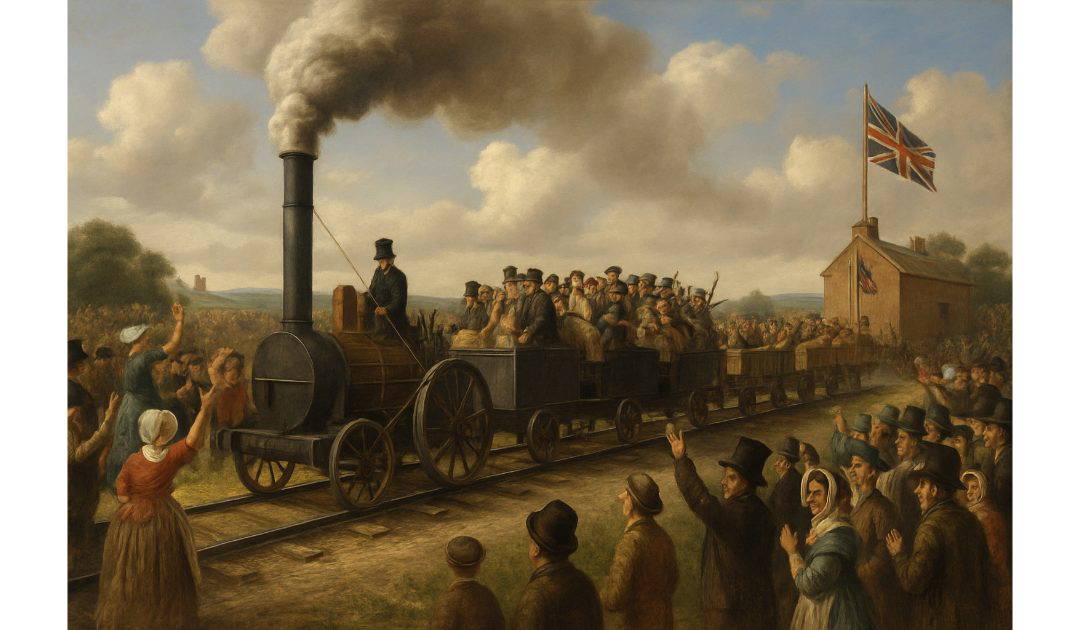During my career as a civil engineer I worked on a number of railway projects including the London, Tilbury, and Southend Resignalling Project, Great Western Renaissance, HS2, and London’s Elizabeth Line. Hence my pick for today’s historical event.
The Stockton and Darlington Railway (S&DR) holds the distinguished title of being the world’s first public railway to use steam locomotives, marking a pivotal moment in transportation history. Officially opened on the 27th of September, 1825, it was a groundbreaking achievement that signified the dawn of the railway age, transforming commerce, industry, and society in ways that still resonate today.
Origins and Conception
The early 19th century was a period of rapid industrial growth in Britain, particularly in the coal-rich regions of the northeast. Traditionally, coal was transported from mines to ports via horse-drawn wagons over rough roads or primitive wooden tramways. These methods were inefficient and costly. Edward Pease, a prominent Quaker businessman from Darlington, recognised the potential for a more efficient system and spearheaded the initiative to establish a railway.
Pease envisaged a railway primarily for transporting coal from the collieries around Shildon in County Durham to the port of Stockton-on-Tees, facilitating easier shipment to markets. In 1821, after considerable lobbying, he secured an Act of Parliament authorising the construction of the Stockton and Darlington Railway. The original plan was for a horse-drawn railway, but this changed dramatically with the involvement of George Stephenson, an accomplished engineer.
Engineering and Construction
George Stephenson, already making a name for himself with his work at Killingworth Colliery, convinced Pease to adopt steam locomotion. Stephenson’s persuasive arguments and technical expertise led to a second Act of Parliament in 1823, allowing for the use of steam engines. Subsequently, Stephenson was appointed the railway’s chief engineer.
Construction commenced in 1822 and presented numerous challenges, including the need to build bridges, cuttings, and embankments to maintain manageable gradients. One notable feature was the Skerne Bridge in Darlington, designed by architect Ignatius Bonomi, which remains in use today, a testament to its robust design.
Opening Day: A Historic Milestone
The grand opening on the 27th of September, 1825, was a momentous occasion, drawing large crowds. The star of the event was “Locomotion No. 1,” built by George and Robert Stephenson at their Newcastle works. Unlike modern steam engines, Locomotion No. 1 was rudimentary, featuring a vertical boiler and chain-driven wheels, but it was revolutionary at the time.
The inaugural train, driven by George Stephenson himself, consisted of 12 wagons of coal and flour, six passenger carriages, and was accompanied by numerous spectators on horseback and on foot. The journey covered the 25-mile route from Shildon to Stockton in just over two hours, with speeds reaching up to 15 miles per hour—astonishing for the era.
Impact and Legacy
The success of the Stockton and Darlington Railway had far-reaching consequences. It demonstrated the viability of steam locomotion for both freight and passenger transport, sparking a railway boom across Britain and eventually the world. The S&DR’s model showcased the economic advantages of railways, leading to rapid expansion and the development of an extensive railway network that became the backbone of the Industrial Revolution.
The S&DR also highlighted the potential for passenger travel. Although initially designed for freight, the popularity of the passenger carriages during the opening run led to the introduction of regular passenger services. This democratised travel, making it accessible to a broader segment of society and fostering greater mobility and urbanisation.
Technological Innovations
While Locomotion No. 1 was groundbreaking, it also had limitations. The experience gained from the S&DR led to rapid technological advancements. George Stephenson’s subsequent designs, such as the famous “Rocket,” incorporated significant improvements, including more efficient boilers and better wheel designs, setting new standards for locomotive engineering.
Additionally, the S&DR pioneered operational practices that became standard across the railway industry. These included timetabled services, signalling systems, and the establishment of railway stations, all contributing to the efficient and safe operation of rail networks.
Preservation and Commemoration
Today, the legacy of the Stockton and Darlington Railway is preserved through various heritage sites and commemorative events. The original trackbed, though largely replaced by modern developments, can still be traced, and several structures, like the Skerne Bridge, stand as historical monuments.
Locomotion No. 1 is preserved and displayed at the Locomotion Museum in Shildon, part of the National Railway Museum. The railway’s bicentenary in 2025 is anticipated with great excitement, promising events and exhibitions celebrating its contribution to global transportation history.

